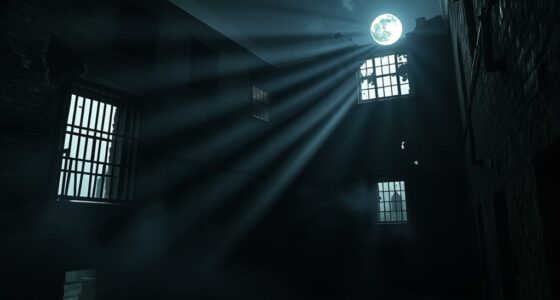The Lizzie Borden House tells a chilling tale of a brutal double murder that shook the nation. In 1892, Lizzie’s parents, Andrew and Abby Borden, were found dead, leading to her sensational trial. The house, now a bed and breakfast, attracts visitors drawn to its ghostly legends and eerie atmosphere. With strange noises and haunting experiences, it’s no wonder this historic site has become a hotspot for dark tourism. Discover what else this infamous place has to offer.
Key Takeaways
- The Borden House, site of the infamous 1892 murders, attracts dark tourism due to its haunted reputation and chilling history.
- Visitors report eerie encounters, strange noises, and ghostly apparitions, enhancing the house’s allure as a true crime ghost story.
- The Borden case intertwines themes of gender and class, influencing public perception and discussions about justice and societal norms.
- The house operates as a bed and breakfast, offering guests unique paranormal experiences and insights into its dark past.
- Preserved as a historical site, the Lizzie Borden House continues to captivate visitors with its blend of true crime and chilling tales.
The History Behind the Borden House
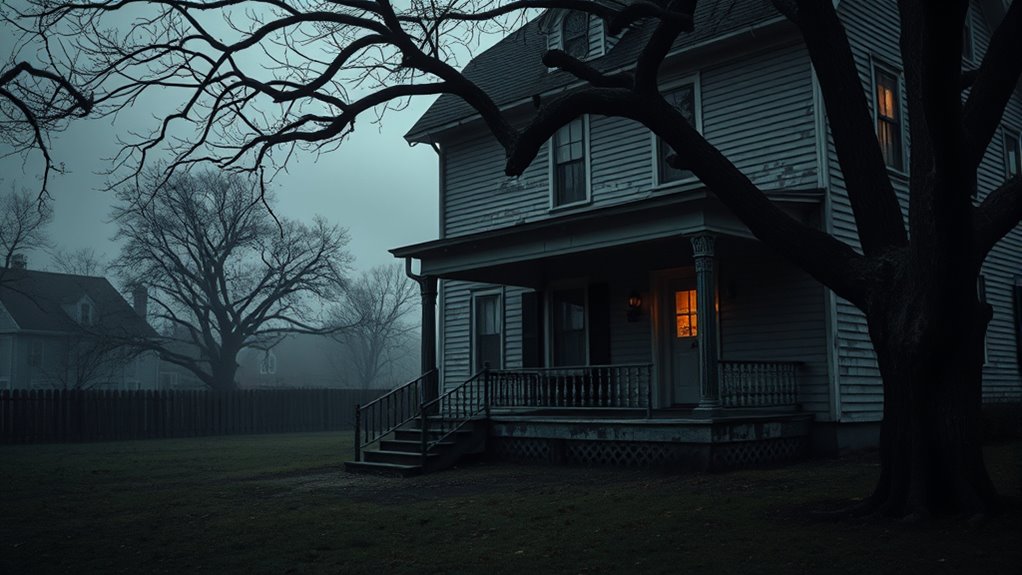
While many know the Borden House for its infamous murders, its history is equally compelling. Purchased by Andrew Borden in 1872, this once two-tenant dwelling transformed into a single-family residence for the Borden family.
You’d find Andrew, his wife Abby, daughters Emma and Lizzie, plus their maid, Bridget Sullivan, living there. Despite their affluent status, the Bordens chose a modest home, reflecting Andrew’s middle-class values. The house lacked modern conveniences like indoor plumbing and electricity, requiring the use of chamber pots and a basement privy. With no hallways, moving through rooms was necessary, creating a unique layout that contributed to the family’s social isolation. This blend of history and architecture adds depth to the Borden House’s story, as it was remodeled from two apartments into a single-family home, showcasing Andrew Borden’s practical approach to living. The Borden family’s choice of residence in a modest home mirrors the middle-class values prevalent in many American households during that era, much like the historical significance of butter’s role in various culinary traditions. Interestingly, the Borden family’s lifestyle might have included elements of cultural influences that shaped their daily life and choices, reflecting the diverse backgrounds present in American society at the time. This practical approach to living aligns with the importance of strategic planning for long-term financial stability, much like the consideration of retirement savings. Additionally, the Borden family likely enjoyed meals that included low-carb meal options, which were becoming increasingly popular during that period.
The Infamous Borden Murders

On August 4, 1892, the Borden House in Fall River became the scene of a horrific double murder that shocked the nation. Wealthy businessman Andrew Borden and his wife, Abby, were brutally murdered with an axe, igniting intense media frenzy. Andrew was struck ten times while resting on the couch, and Abby suffered nineteen blows in the guest room. Eyewitness accounts soon pointed to Lizzie Borden, the couple’s daughter, who was seen acting suspiciously, even destroying a dress she claimed was stained with paint. Despite a thorough investigation, the lack of forensic evidence left many questions unanswered. The gruesome details and family dynamics fueled theories of financial motives and emotional abuse, forever marking the Borden case in true crime history. Tensions in the household were noted, particularly regarding Andrew’s gifts of real estate to Abby’s relatives. This dark chapter in history also sparked discussions about the importance of high-quality equipment in documenting such notorious events through sound recordings.
Key Details From the Trial
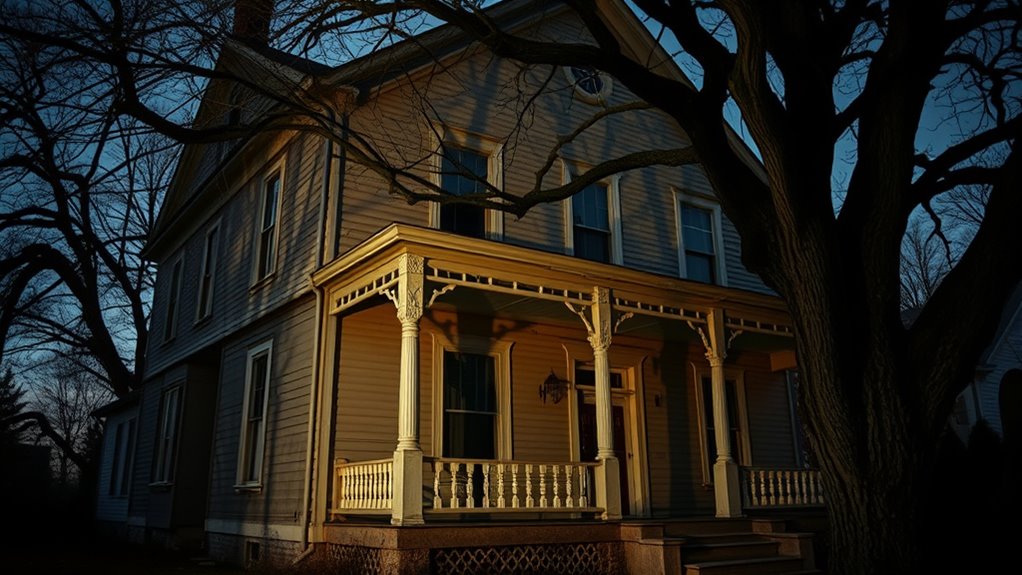
The trial of Lizzie Borden captured the nation’s attention, unfolding as a dramatic spectacle filled with twists and legal maneuvering. Arrested on August 11, 1892, Lizzie faced accusations of murdering her father and stepmother. During the preliminary hearing, Judge Josiah Blaisdell deemed her “probably guilty.” However, her inquest testimony was ruled inadmissible, affecting the prosecution’s case. Key evidence included her changed dress and a hatchet head found in the basement, but the jury found the prosecution’s theories unconvincing. Notably, the murders occurred on August 4, 1892, a critical date that set the stage for this infamous case. As the defense presented their case, the importance of effective communication became evident in revealing inconsistencies in witness testimonies. After a lengthy trial, Lizzie was acquitted on June 20, 1893. The defense effectively challenged evidence and highlighted procedural flaws, while gender narratives subtly influenced the courtroom dynamics throughout this sensational trial. This case remains a topic of fascination and speculation, reflecting wider societal issues, including mental health disorders and their impact on behavior and perceptions of guilt. Furthermore, the lack of accountability for actions can complicate the public’s understanding of the case’s nuances. Additionally, the dynamics of the trial bear resemblance to the emotional manipulation often seen in narcissistic relationships, highlighting how personal interactions can shape legal outcomes. Furthermore, the case’s complexities echo the importance of first aid kits in ensuring proper responses to emergencies.
Media Frenzy and Public Interest
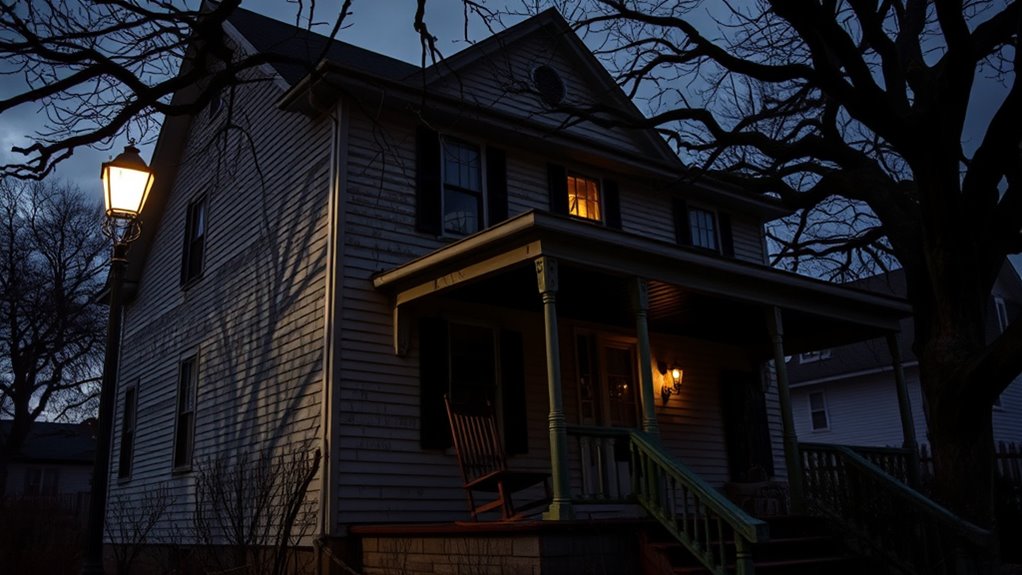
As news of Lizzie Borden’s trial spread across the United States, a media frenzy erupted, engrossing the public and igniting debates on gender and class.
The shocking nature of the crime—a young woman accused of brutally murdering her parents with an ax—captivated imaginations. The infamous murder mystery surrounding the Borden case further fueled the media’s obsession, as they sought to uncover every detail. Many were drawn to the case due to its complex dynamics, mirroring the strong communication skills often needed in relationships that can complicate family ties. The intense scrutiny of Lizzie’s actions revealed the importance of emotional intelligence in managing public perception and personal crisis. Additionally, the sensational nature of the case highlighted the role of media’s influence in shaping narratives around women and crime. Virtual affairs can also lead to significant emotional distress, akin to the turmoil surrounding Lizzie’s case. The impact of the case on public consciousness has parallels with how hydrocolloid technology promotes healing in skincare, drawing attention to the need for targeted solutions in crises.
The media played an essential role in shaping public opinion, with headlines swinging between portraying Lizzie as innocent or guilty. Some outlets highlighted her social status, while others focused on her strained family relationships.
This frenzy brought Fall River to a standstill, as the trial unfolded amid discussions on women’s rights and classism.
Ultimately, the case’s brutality and historical context guaranteed its place in true crime lore, fueling ongoing fascination.
The Aftermath for Lizzie Borden
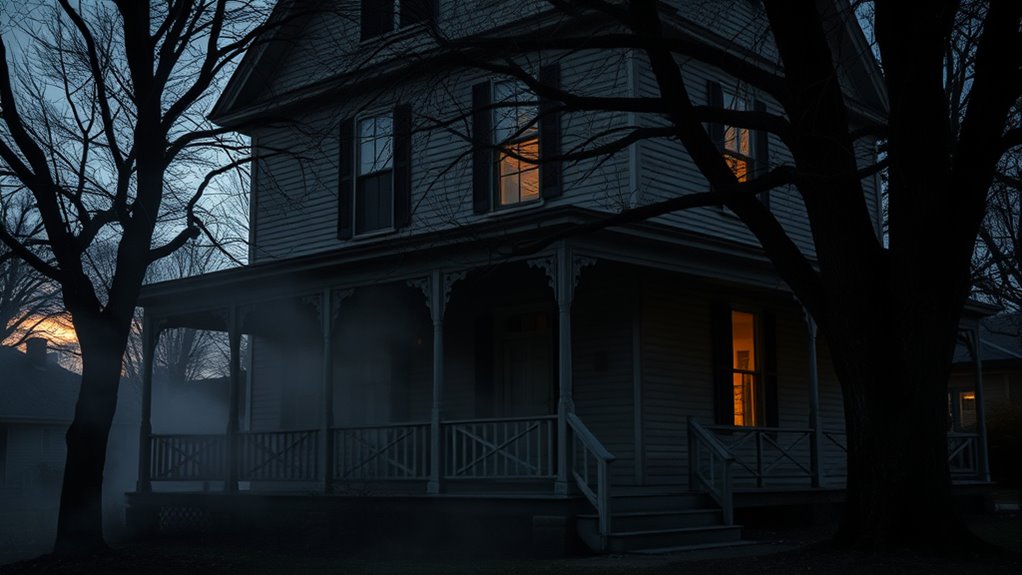
Despite her acquittal, Lizzie Borden’s life took a dramatic turn, marked by social ostracism and public scrutiny. The community in Fall River shunned her, leaving her isolated in a town that once embraced her. While women’s rights groups rallied for her, citing the absence of female jurors, the public remained divided on her innocence. Financially, her inheritance provided stability, allowing her to maintain a comfortable lifestyle, but her relationship with her sister Emma soured over time. The psychological toll of the trial was evident; prescribed morphine calmed her nerves during the inquest. This high-profile case, which captivated the nation, became a reflection of the cultural, religious, class, and gender divisions in Fall River at the time. The intense scrutiny surrounding her life also mirrored the unexplained phenomena that often arise in such sensational cases. Mindfulness practices may have offered her some solace in navigating her turbulent emotions during this period. Furthermore, the psychological impact of such public scrutiny can lead to long-lasting effects on mental health. Engaging in spiritual retreats could have provided Lizzie an opportunity for healing and self-discovery in the aftermath of her trials. Notably, her life also serves as a reminder of the importance of faith and resilience when facing adversity.
Lizzie Borden faced isolation and judgment in Fall River, despite her acquittal, as the community turned against her.
Ultimately, Lizzie became a historical figure, her case a lasting enigma that continues to fascinate and provoke debate.
Dark Tourism and Its Appeal
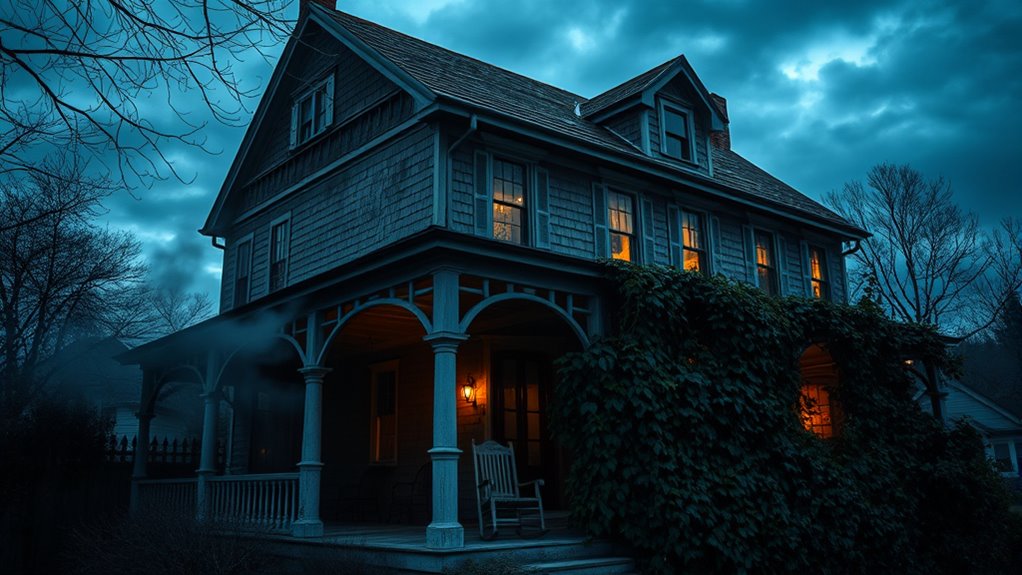
While many travelers seek sun-soaked beaches and bustling cityscapes, a growing number are drawn to the darker side of tourism, known as dark tourism. This form of travel takes you to places steeped in history, tragedy, and even death, like the Lizzie Borden House. Engaging with these sites, you can experience a unique emotional journey that contrasts sharply with everyday life. Dark tourism encourages introspection, allowing you to reflect on how past tragedies shape our modern society. Notably, dark tourism encompasses various motivations that drive individuals to explore these poignant locations. The emotional impact of these experiences can be similar to the emotional volatility found in relationships affected by mental health issues. Additionally, visiting such sites can evoke the same chronic stress that many survivors of narcissistic abuse endure. The exploration of dark tourism can also mirror the impact of parental infidelity on individuals, revealing how past traumas influence current behaviors and relationships. Whether it’s visiting former prisons or disaster zones, the fascination with ruin and historical significance fuels your curiosity. However, it’s essential to approach these sites with respect and understanding, acknowledging the sensitive nature of their histories.
Ghost Stories and Legends
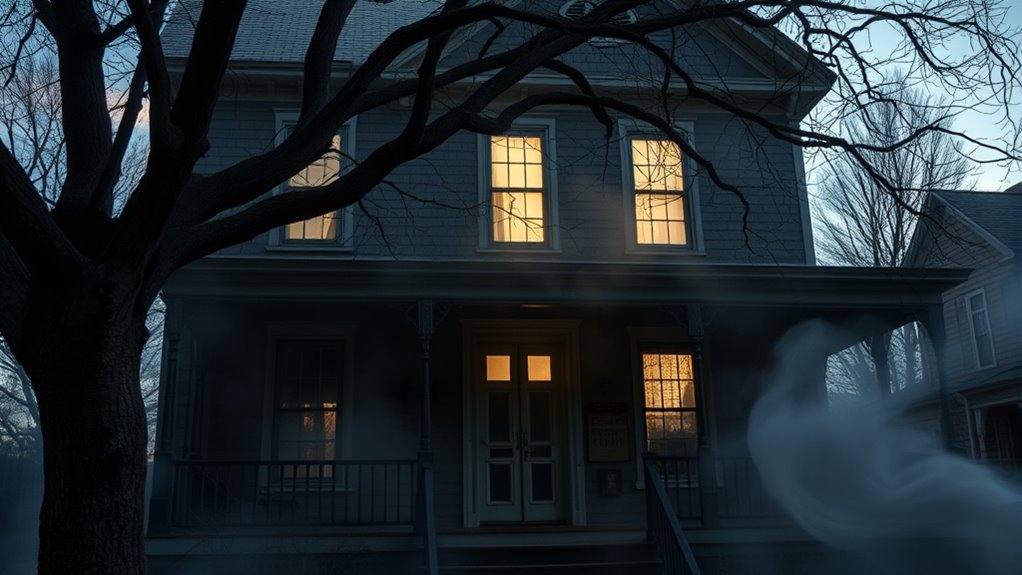
Ghost stories have a way of capturing your imagination, especially when they’re tied to real events like the infamous murders at the Lizzie Borden House. Visitors often report eerie encounters, claiming to see Lizzie Borden herself or feel the presence of children who once lived there. Strange noises, ghostly apparitions, and unexplained fire alarms going off at odd times add to the house’s haunted reputation. Photographs frequently capture mysterious figures, fueling curiosity and fear. The house draws those fascinated by true crime and the supernatural, blending history with chilling tales. Each story shared adds another layer to its legend, ensuring that the Lizzie Borden House remains a mesmerizing destination for thrill-seekers and ghost enthusiasts alike. Many of these tales echo the theme of urban legends, where truth and fiction intertwine to create an enduring sense of fear and intrigue.
Preservation Efforts and Tourism Today
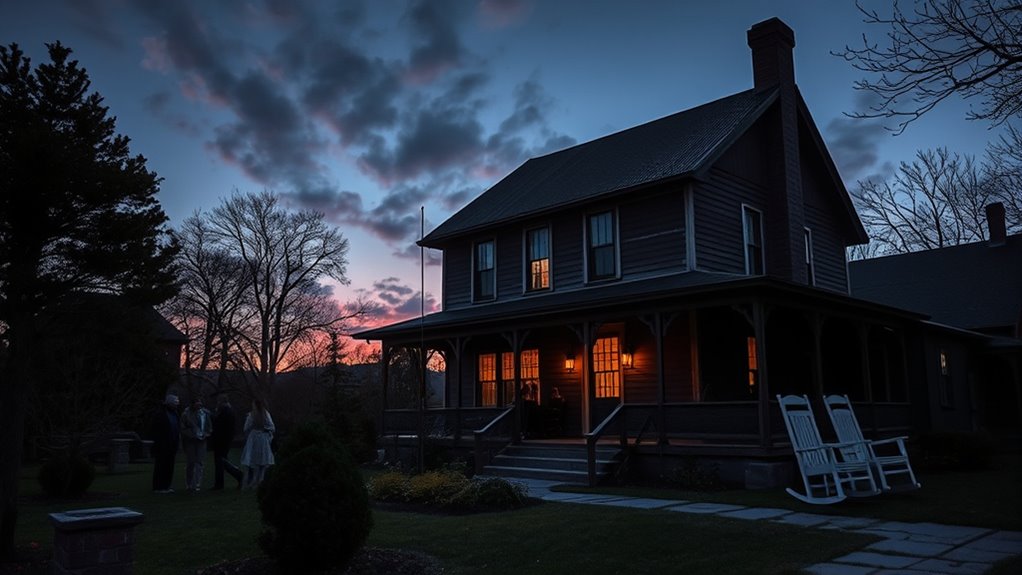
As the Lizzie Borden House continues to draw visitors intrigued by its dark history, preservation efforts play an essential role in maintaining its allure.
Owned by US Ghost Adventures since May 2021, the house benefits from renovations that preserve its Victorian-era architecture and eerie ambiance. Proceeds from events and sales support ongoing maintenance, ensuring the historical integrity remains intact. The renovations aim to maintain the authenticity of the site, allowing visitors to fully appreciate its historical context.
You can experience this unique site as a bed and breakfast, where you might even encounter paranormal activity. Guided tours and annual reenactments of the Borden murders enhance your visit, immersing you in its storied past.
With virtual tours in development, the house’s cultural significance continues to attract tourists, boosting the local economy and creating jobs in Fall River.
The Legacy of the Borden Case
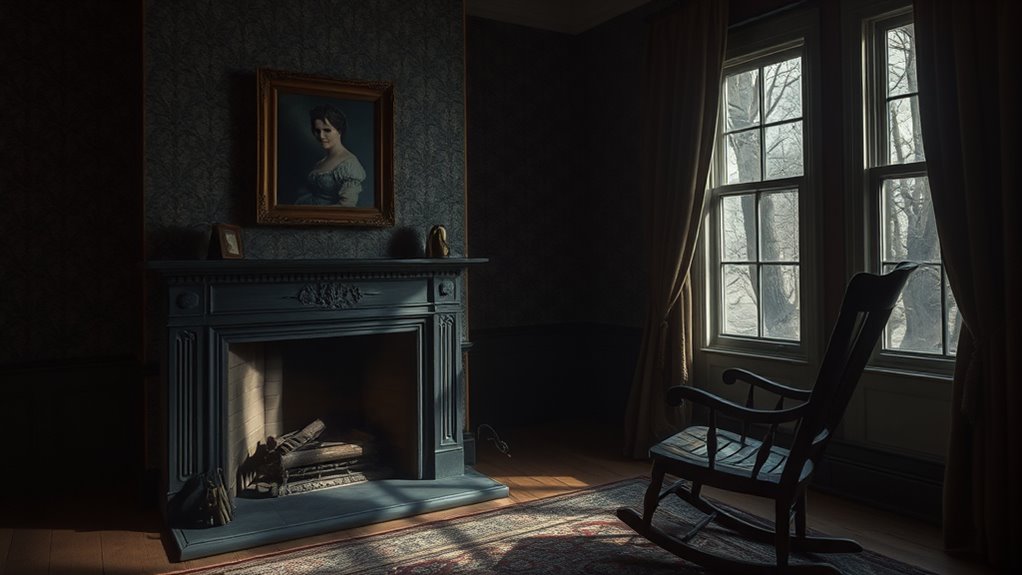
The legacy of the Borden case endures, enchanting audiences with its blend of mystery and social commentary. You’ll find the story captivating not just for its gruesome details but also for the societal influences at play—class, gender stereotypes, and nativism shaped public perception and Lizzie’s acquittal. Furthermore, the fact that Lizzie Borden was arrested on August 11, 1892, adds a layer of legal intrigue to the narrative surrounding the case.
As you explore, you’ll see how the case sparked national fascination, leading to countless adaptations in literature and film. It’s a cornerstone of true crime culture, prompting discussions about justice and societal roles. The community’s mixed reactions reflect the complexities of human relationships, while flaws in the original investigation highlight legal challenges. Overall, the Borden case remains a compelling study of the intersection between crime and society.
Frequently Asked Questions
What Were the Living Conditions Like in the Borden House?
The living conditions in the Borden house were quite basic and functional for the time.
You’d find that it originally served as a two-family residence, with limited amenities. The upstairs lacked a hallway, and the kitchen features remained in Lizzie’s room.
Heating relied on a coal-fired furnace, and access to water was inside the house.
How Did Andrew Borden Acquire His Wealth?
Imagine a man so shrewd, he could turn a pocketful of pennies into a fortune!
Andrew Borden did just that, amassing wealth through banking, textile mills, and savvy real estate investments. He dabbled in the casket business and owned numerous rental properties, all while living like a frugal monk.
His relentless ambition and sharp business acumen propelled him from humble beginnings to prominence in Fall River, making him a financial powerhouse of his time.
Did Lizzie Borden Have Any Siblings?
Yes, Lizzie Borden had one sibling, an older sister named Emma Lenora Borden. Born in 1851, Emma lived until 1927.
The sisters grew up in a wealthy family but had a complicated relationship, especially with their stepmother, Abby. They often distanced themselves from family tensions, going on extended vacations together.
Despite their shared upbringing, their bond was strained, reflecting the complexities of their family dynamics.
What Role Did Bridget Sullivan Play in the Borden Family?
Imagine a quiet household where secrets linger like shadows.
Bridget Sullivan, the Irish maid, played an essential role in the Borden family. You’d find her steering through daily routines, often supporting Lizzie during domestic disputes.
Present on the day of the infamous murders, Bridget’s testimony became significant, painting a picture of family dynamics.
While she maintained a pleasant facade, her loyalty to Lizzie and her secrets shaped the narrative of this tragic tale.
Are There Any Books or Films About the Borden Case?
Yes, there are several books and films about the Borden case.
You might find “The Trial of Lizzie Borden” by Cara Robertson intriguing, or “The Borden Murders” by Sarah Miller, which offers a detailed perspective.
For films, check out “Lizzie” (2018) starring Chloe Sevigny or the classic “The Legend of Lizzie Borden” (1975).
Each of these media pieces brings a unique viewpoint to the infamous case you’re interested in.
Conclusion
In the end, the Lizzie Borden house stands as a chilling monument to a gruesome past that still captivates the imagination of many. You can’t help but feel the weight of its dark history as you walk through its rooms. Whether you’re drawn by the true crime story, the ghostly legends, or the allure of dark tourism, this iconic site offers an experience that’s nothing short of spine-tingling. You might even leave with a ghost story of your own!




